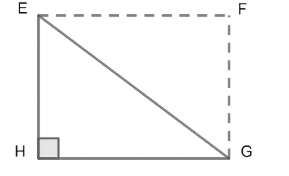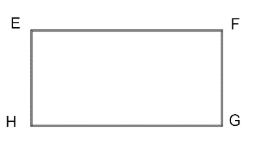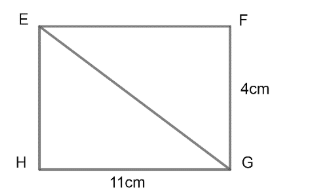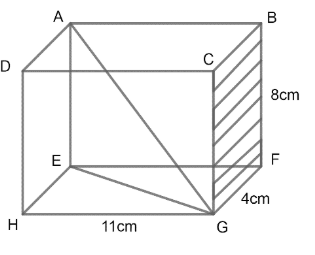
Answer
479.4k+ views
Hint: If we consider the triangle formed by EGH, $\angle EGH=90{}^\circ $, EG will be the hypotenuse, we can get the length of EH as we know the length of FG and we also know the length of HG. By applying the formula $''{{\left( hypotenuse \right)}^{2}}={{\left( side1 \right)}^{2}}+{{\left( side2 \right)}^{2}}''$in $\Delta EHG$, we will get the length of EG.
Complete step-by-step answer:
A cuboid is defined as a solid which has six rectangular faces at right angles to each other.
We have to find the length of EG. For this let us consider the triangle formed by EHG.

We know that all the faces of a cuboid are rectangular. So, quadrilateral HEFG will also be a rectangle. We can observe in the above diagram that $\angle EHG$ is one corner of the rectangle HEFG. Hence, $\angle EHG=90{}^\circ $.
So, $\Delta EHG$ will be a right triangle with $\angle EHG=90{}^\circ $and EG is the hypotenuse of this right triangle.
We know, $''{{\left( hypotenuse \right)}^{2}}={{\left( side1 \right)}^{2}}+{{\left( side2 \right)}^{2}}''$
${{\left( EG \right)}^{2}}={{\left( HE \right)}^{2}}+{{\left( HG \right)}^{2}}...............\left( 1 \right)$
To find the length of the hypotenuse (i.e. EG), we need to find the length of other two sides;
HG = 11 cm (Given in the diagram of the question)
We know, that the opposite sides of a rectangle are same so for rectangle HEFG, HE = FG

And FG = 4 cm (Given in the diagram of the question)
So, HE = 4 cm.
Now, on putting HE = 4 cm and HG = 11 cm in equation (1),
We will get;
\[\begin{align}
& {{\left( EG \right)}^{2}}={{\left( 4cm \right)}^{2}}+{{\left( 11cm \right)}^{2}} \\
& \Rightarrow {{\left( EG \right)}^{2}}=16c{{m}^{2}}+121c{{m}^{2}} \\
& \Rightarrow {{\left( EG \right)}^{2}}=137c{{m}^{2}} \\
\end{align}\]
Taking positive square root both sides, we will get;
$\Rightarrow EG=\pm \sqrt{137}cm$
We have taken positive square roots because the length of the side cannot be negative.
$\Rightarrow EG=11.70cm$
Hence, the required length of the EG = 11.70 cm.
Note: Another method;
We can calculate the length of EG by considering the rectangle HEFG. EG is a diagonal of the rectangle.

Formula:
$\left( \text{length}\ \text{of}\ \text{diagonal }\text{of}\ \text{a}\ \text{rectangle} \right)=\sqrt{{{a}^{2}}+{{b}^{2}}}$
Where ‘a’ and ‘b’ is its length and breadth.
\[\Rightarrow EG=\sqrt{{{\left( 4cm \right)}^{2}}+{{\left( 11cm \right)}^{2}}}\]
\[\begin{align}
& =\sqrt{137}cm \\
& =11.70cm \\
\end{align}\]
Complete step-by-step answer:
A cuboid is defined as a solid which has six rectangular faces at right angles to each other.
We have to find the length of EG. For this let us consider the triangle formed by EHG.

We know that all the faces of a cuboid are rectangular. So, quadrilateral HEFG will also be a rectangle. We can observe in the above diagram that $\angle EHG$ is one corner of the rectangle HEFG. Hence, $\angle EHG=90{}^\circ $.
So, $\Delta EHG$ will be a right triangle with $\angle EHG=90{}^\circ $and EG is the hypotenuse of this right triangle.
We know, $''{{\left( hypotenuse \right)}^{2}}={{\left( side1 \right)}^{2}}+{{\left( side2 \right)}^{2}}''$
${{\left( EG \right)}^{2}}={{\left( HE \right)}^{2}}+{{\left( HG \right)}^{2}}...............\left( 1 \right)$
To find the length of the hypotenuse (i.e. EG), we need to find the length of other two sides;
HG = 11 cm (Given in the diagram of the question)
We know, that the opposite sides of a rectangle are same so for rectangle HEFG, HE = FG

And FG = 4 cm (Given in the diagram of the question)
So, HE = 4 cm.
Now, on putting HE = 4 cm and HG = 11 cm in equation (1),
We will get;
\[\begin{align}
& {{\left( EG \right)}^{2}}={{\left( 4cm \right)}^{2}}+{{\left( 11cm \right)}^{2}} \\
& \Rightarrow {{\left( EG \right)}^{2}}=16c{{m}^{2}}+121c{{m}^{2}} \\
& \Rightarrow {{\left( EG \right)}^{2}}=137c{{m}^{2}} \\
\end{align}\]
Taking positive square root both sides, we will get;
$\Rightarrow EG=\pm \sqrt{137}cm$
We have taken positive square roots because the length of the side cannot be negative.
$\Rightarrow EG=11.70cm$
Hence, the required length of the EG = 11.70 cm.
Note: Another method;
We can calculate the length of EG by considering the rectangle HEFG. EG is a diagonal of the rectangle.

Formula:
$\left( \text{length}\ \text{of}\ \text{diagonal }\text{of}\ \text{a}\ \text{rectangle} \right)=\sqrt{{{a}^{2}}+{{b}^{2}}}$
Where ‘a’ and ‘b’ is its length and breadth.
\[\Rightarrow EG=\sqrt{{{\left( 4cm \right)}^{2}}+{{\left( 11cm \right)}^{2}}}\]
\[\begin{align}
& =\sqrt{137}cm \\
& =11.70cm \\
\end{align}\]
Recently Updated Pages
Who among the following was the religious guru of class 7 social science CBSE

what is the correct chronological order of the following class 10 social science CBSE

Which of the following was not the actual cause for class 10 social science CBSE

Which of the following statements is not correct A class 10 social science CBSE

Which of the following leaders was not present in the class 10 social science CBSE

Garampani Sanctuary is located at A Diphu Assam B Gangtok class 10 social science CBSE

Trending doubts
Which are the Top 10 Largest Countries of the World?

In what year Guru Nanak Dev ji was born A15 April 1469 class 11 social science CBSE

A rainbow has circular shape because A The earth is class 11 physics CBSE

How do you graph the function fx 4x class 9 maths CBSE

Fill the blanks with the suitable prepositions 1 The class 9 english CBSE

In Indian rupees 1 trillion is equal to how many c class 8 maths CBSE

The Equation xxx + 2 is Satisfied when x is Equal to Class 10 Maths

Why is there a time difference of about 5 hours between class 10 social science CBSE

Difference between Prokaryotic cell and Eukaryotic class 11 biology CBSE





